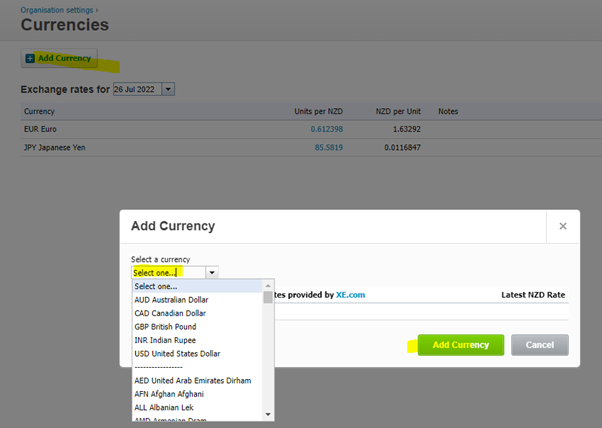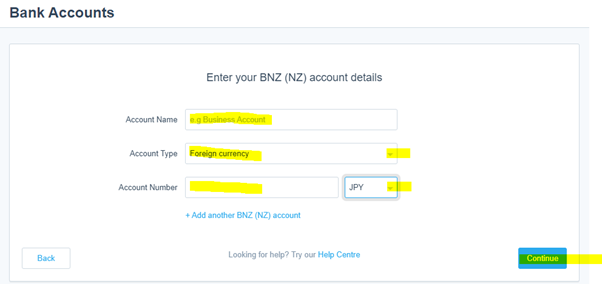Foreign Currency and Xero
Do you trade internationally? Would you like to be able to send invoices, quotes, and purchase orders, or receive bills and payments from overseas?
If you trade using any international currency, getting multi-currency set up in your Xero is a must-do. In this article, we talk through setting it up and the benefits it will provide you.
What Xero plan provides Multi-Currency?
To use multi-currency in Xero you need to be on the Premium plan. You may need to upgrade your plan to be on Premium. This can be done by the subscription holder of your Xero file and is accessed through the subscription and billing link found in your Xero organisation.
How does Xero's Multi-Currency service work?
Multi-Currency can be used to invoice your customers and receive payments in 160 currencies.Xero is connected to the Foreign Exchange, so the rates of exchange are updated hourly to align with the market.
Another benefit is you don’t need to worry about choosing an exchange rate when you have a transaction to process, this will happen for you automatically. However, you will need to set up which currencies you trade in, within your Xero first (before adding the foreign bank account to your dashboard) i.e. - USD, Yen etc.
To choose your currencies, go into your Xero settings, then into the foreign currencies section, and add the relevant currencies. You must have either Standard or Adviser user permissions.

How do I set up Multi-Currency in my Xero file?
To set up your bank account in Xero for foreign currency and to enable transactional bank feeds to come through daily (like your other bank accounts in Xero) follow these steps:
- go into Accounting
- Bank Accounts
- and Add Bank Account
- select the banking provider
- enter bank account name (eg: USD account)
- account number
- choose “Foreign Currency” for the account type
- then select the relevant currency from the drop-down box.
- Follow the on-screen prompts to activate these bank feeds
- print bank feed form, sign, and upload.
Feeds can take up to 10 business days to activate.


Please note that not all banks support foreign currency direct feeds into Xero. To check if yours does please search ‘Direct Bank Feeds for your Region’ in Xero Central and click on the link for your bank.
How to process a foreign currency sale or bill in Xero
When you have a foreign currency sales invoice or bill to enter into Xero, the process is very similar to a normal New Zealand currency sales invoice/bill, however, as you enter it you will see there is a Currency drop arrow just below the “To or From” contact. Here you select the currency that the sales invoice or bill is showing in (or should show in). It will automatically exclude GST for you.
Once this invoice is paid, the transaction will come through in your bank feeds, and you will need to match the payment to the invoice. To do this:
- select Match
- untick the box that says “Show NZD items only”
- the invoice paid should now show as an option
- tick the box beside it
- Reconcile.

What are foreign currency gains and losses?
When you sell products or services to customers in a foreign currency, the value of that currency changes based on the exchange rate. However, exchange rates themselves can also change at random. If the exchange rate changes and the value of the currency goes up or comes down after you invoice a customer, but before you collect payment, then you have made a foreign currency gain or loss on that invoice. Gains and losses are either realised or unrealised. The difference between them depends on if the invoice is paid or not. It is unrealised while the invoice is awaiting payment. Once paid, it can calculate the actual realised gain/loss.
When you look at Xero’s Dashboard, the value you see on the screen for that foreign bank account, is in the foreign currency, not New Zealand Dollar (NZD) value.
Reporting with Foreign Currencies
Reporting with Foreign Currencies looks a bit different from normal reporting in Xero. For example, when you run a Balance Sheet Report, Xero will show the value of the foreign bank account to be in NZD. It will have a Footnote number beside it, referring to a note at the bottom of the report explaining what Exchange Rate was used in the report.
If you would like assistance setting up foreign exchange Multi-Currency in your Xero, get in touch with one of our friendly team members today. Our team understands the ins and outs of Xero and can assist you to set it up so that it works optimally for you.
If you are looking at getting into Foreign Currency trading in a detailed way, we would suggest you refer to an FX banking specialist, so they can give you a more detailed approach to rates, market information, and details on different options available to you.

The above information is general and does not represent tailored advice to your business. For more specific guidance, get in touch with our team who can connect you with one of our bookkeeping experts.
Read our other bookkeeping guides
Keeping the books up to date is critical for any business. Letting things get disorganised is going to create big headaches down the road, so it pays to have systems in place that prevent this. But don’t worry - as a business owner you aren’t expected to necessarily manage all of this process alone. After all, you’ll want to be focusing on the things you’re most effective at (and enjoy!).
Bringing on an employee is a big step in the life of a business. It represents growth and new skills coming into the fold. With over half a million small-medium businesses in New Zealand, there’s a huge amount of pay runs being processed each week. If you’re new to the world of paying employees, it can feel a bit daunting getting your head around the tax obligations and admin. However, there's no need to worry...
Keeping on top of your expenses is key to running a healthy business. Over-extended businesses leave themselves open to real financial headaches, and when a business continually pays late, the relationships with those creditors can suffer or even disappear. Establishing tight practices around paying as much as receiving payments gives the business much more clarity on its position at any given time.
So, how does a business best approach bill payments?
Waiting for an invoice to be paid after the due date has passed can put tremendous strain on the cash flow of the business. If late invoices become ‘normal’ for the business, it’s harder to grow and invest back in the business.
In this guide we’ll talk about aged receivables in more detail and what you can do to reduce and even eliminate this problem from your business.


